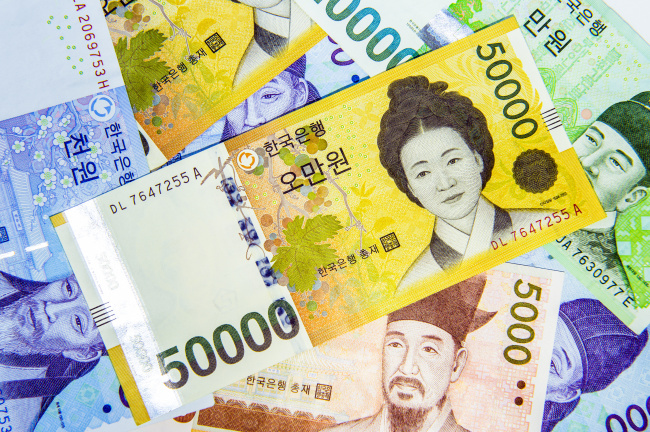Korea’s ample money supply not translating into circulation
Koreans are piling up deposits instead of spending them amid increased uncertainties
By Korea HeraldPublished : Jan. 17, 2017 - 14:29
The money supply in South Korea has rapidly grown in recent months, but this has not translated into fast circulation amid weak sentiment toward investment and consumption, data from the central bank showed Tuesday.
According to the Bank of Korea, the balance of currency issuance hit a record high of 97.4 trillion won ($82.7 billion) at the end of 2016, a 12.2 percent increase from 86.8 trillion won a year earlier.
According to the Bank of Korea, the balance of currency issuance hit a record high of 97.4 trillion won ($82.7 billion) at the end of 2016, a 12.2 percent increase from 86.8 trillion won a year earlier.

The strong cash growth was attributed to a rapid increase in issuance of 50,000-won bills, which amounted to 23 trillion won in 2016, the largest since Korea introduced the bill in 2009.
Apparently affected by the BOK’s expansionary policy to support growth since August 2014, the size of M2, or the broader money supply including savings deposits, money market securities and mutual funds, as well as cash and checking deposits, also rose 7.3 percent to reach a total of 2,405.1 trillion won in November from 2,240.8 trillion won a year earlier.
However, the growth in money supply is in contrast to money circulation indicators that stayed at low levels.
The money multiplier, or the ratio between the money supply and the monetary base showing how much currency the base money creates, hit a record low of 16.7 in November, BOK data showed.
The demand deposit turnover ratio, the proportion of deposit allowance to the balance of deposit, plunged to 20.3 in the same month from 24.3 at the end of 2015.
The lower the ratio, the less people withdraw their deposits.
Concerned over economic uncertainties, Koreans are piling up deposits in banks instead of spending them.
The total balance of fixed time deposits at banks rose by 19.8 trillion won in 2016, the largest volume in four years since a 20.4 trillion won gain in 2012, another set of data from the BOK showed.
Even though the average interest rate of fixed time deposits was a record low of 1.49 percent in November, demand for fixed time deposits rose due to market uncertainty, observers said.
Meanwhile, Koreans are increasingly pinching pennies as their income growth falls far short of the rising prices of daily necessities.
According to Statistics Korea, the average monthly income of households consisting of more than two family members inched up only 0.65 percent to 4.44 million won in the third quarter of last year, from 4.41 million won a year earlier.
However, prices of some agricultural products have shot up. Prices of Western cabbage and Chinese cabbage jumped 131 percent and 96 percent, respectively, over the cited period, according to Korea Agro-Fisheries & Food Trade. In Seoul, the prices of gimbap, or Korean rice rolls, rose 9.7 percent from 3,400 won to 3,731 won per serving on average, according to data from the Korea Consumer Agency.
BOK Gov. Lee Ju-yeol recently said that weak private consumption was the largest factor in the revision of the 2017 growth forecast from 2.8 percent to 2.5 percent.
By Kim Yoon-mi (yoonmi@heraldcorp.com)
-
Articles by Korea Herald







![[Graphic News] More Koreans say they plan long-distance trips this year](http://res.heraldm.com/phpwas/restmb_idxmake.php?idx=644&simg=/content/image/2024/04/17/20240417050828_0.gif&u=)
![[KH Explains] Hyundai's full hybrid edge to pay off amid slow transition to pure EVs](http://res.heraldm.com/phpwas/restmb_idxmake.php?idx=644&simg=/content/image/2024/04/18/20240418050645_0.jpg&u=20240419100350)






![[From the Scene] Monks, Buddhists hail return of remains of Buddhas](http://res.heraldm.com/phpwas/restmb_idxmake.php?idx=652&simg=/content/image/2024/04/19/20240419050617_0.jpg&u=20240419175937)

![[KH Explains] Hyundai's full hybrid edge to pay off amid slow transition to pure EVs](http://res.heraldm.com/phpwas/restmb_idxmake.php?idx=652&simg=/content/image/2024/04/18/20240418050645_0.jpg&u=20240419100350)

![[Today’s K-pop] Illit drops debut single remix](http://res.heraldm.com/phpwas/restmb_idxmake.php?idx=642&simg=/content/image/2024/04/19/20240419050612_0.jpg&u=)